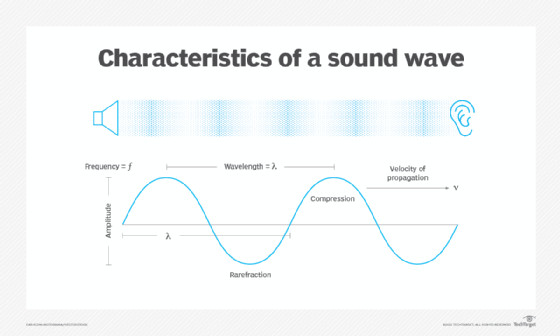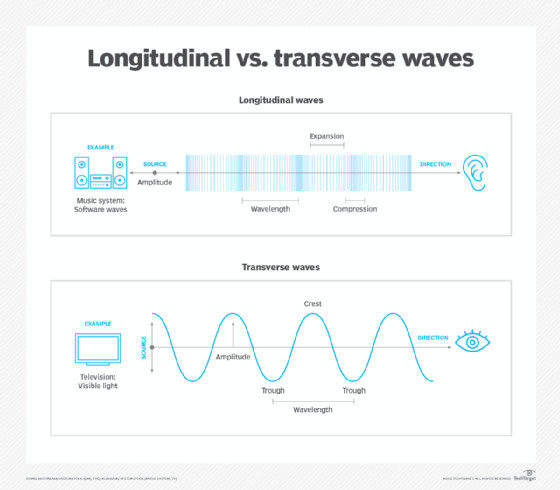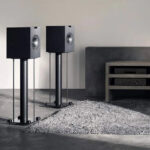Does Sound Travel In Transverse Waves? Sound, in its most common form, doesn’t travel in transverse waves but mainly propagates as longitudinal waves, especially in mediums like air. Streetsounds.net helps you to explore and understand the science behind urban audio. Dive in to discover how sound manifests in unique ways in the streets.
1. What Are Transverse and Longitudinal Waves? Understanding the Basics
Transverse and longitudinal waves are two fundamental types of waves that describe how energy moves through a medium, which can affect how we perceive sound. Knowing the difference is crucial in understanding the movement of sound waves.
1.1. Transverse Waves Explained
Transverse waves are waves where the displacement of the medium is perpendicular to the direction of propagation of the wave.
- Direction: Particles move up and down, or side to side, while the wave travels horizontally.
- Medium: Typically occurs in solids and liquids.
- Example: Light waves, waves on a string.
1.2. Longitudinal Waves Explained
Longitudinal waves are waves where the displacement of the medium is in the same direction as, or parallel to, the direction of propagation of the wave.
- Direction: Particles move back and forth in the same direction as the wave.
- Medium: Can occur in solids, liquids, and gases.
- Example: Sound waves in air.
2. How Does Sound Primarily Travel? The Nature of Sound Waves
Sound primarily travels as longitudinal waves, where the particles of the medium vibrate parallel to the direction of the wave’s propagation. This creates compressions and rarefactions.
2.1. Compression and Rarefaction
Compression and rarefaction form the core mechanism of sound transmission through a medium. Understanding these concepts helps clarify how sound waves propagate.
- Compression: Regions of high pressure where particles are close together.
- Rarefaction: Regions of low pressure where particles are spread apart.
- Mechanism: A vibrating object pushes air molecules, creating compressions, which then spread out, followed by rarefactions as the object moves back.
2.2. Sound in Different Mediums
The medium through which sound travels significantly impacts its speed and efficiency. Different states of matter exhibit unique properties affecting sound wave propagation.
| Medium | State | Sound Propagation |
|---|---|---|
| Air | Gas | Slower due to lower density, longitudinal waves. |
| Water | Liquid | Faster than air due to higher density, longitudinal waves. |
| Steel | Solid | Fastest due to strong intermolecular bonds. |
2.3. Sound and Air Particles
Sound waves cause air particles to vibrate back and forth in the same direction as the wave is moving. This movement creates areas of compression, where particles are closer together, and rarefaction, where particles are more spread out. These alternating compressions and rarefactions propagate through the air, carrying the sound energy.
3. Can Sound Travel as Transverse Waves? Exploring Exceptions
Sound typically doesn’t travel as transverse waves, but under specific circumstances, particularly in solids, it can exhibit transverse characteristics. These conditions involve shear forces within the material.
3.1. Shear Waves in Solids
Shear waves, or transverse waves, can occur in solids where particles move perpendicular to the wave’s direction due to shear forces. These waves are critical in fields like seismology and material science.
- Shear Force: A force that causes deformation of a material by slippage along a plane or planes parallel to the imposed stress.
- Seismology: Used to study earthquakes and the Earth’s structure.
- Material Science: Helps in understanding the mechanical properties of solids.
3.2. Why Not in Liquids and Gases?
Liquids and gases usually do not support transverse waves because their particles can easily slide past each other. They lack the rigid structure needed to sustain shear forces.
- Liquids: Particles are close but can move freely.
- Gases: Particles are widely spaced with weak interactions.
3.3. Examples of Transverse Sound Waves
While rare, examples of transverse sound waves can be found in specific scenarios involving solids. One notable instance is in seismology, where shear waves (S-waves) are studied to understand the Earth’s structure. Additionally, in material science, analyzing transverse waves helps characterize the mechanical properties of solid materials, offering insights into their rigidity and elasticity.
4. Why Does It Matter? Implications and Applications
Understanding how sound travels as longitudinal or transverse waves has significant implications across various fields, influencing technological advancements and scientific research.
4.1. Audio Technology
Audio technology relies heavily on the principles of sound wave propagation. Microphones, speakers, and acoustic treatments are designed based on how sound behaves as a longitudinal wave in air.
- Microphones: Convert sound waves into electrical signals.
- Speakers: Convert electrical signals back into sound waves.
- Acoustic Treatments: Control reflections and reverberations in spaces.
4.2. Geophysics
In geophysics, the study of seismic waves, including both longitudinal (P-waves) and transverse (S-waves), provides critical information about the Earth’s interior. The behavior of these waves helps scientists map subsurface structures and understand earthquake dynamics.
- P-waves (Primary waves): Longitudinal waves that can travel through solids, liquids, and gases.
- S-waves (Secondary waves): Transverse waves that can only travel through solids.
4.3. Medical Ultrasound
Medical ultrasound uses high-frequency sound waves to create images of internal body structures. Although primarily longitudinal, understanding wave behavior is crucial for image clarity and diagnostic accuracy.
- Imaging: Visualizing organs, tissues, and blood flow.
- Therapy: Focused ultrasound can be used for targeted treatments.
5. Sound in Urban Environments: Streetsounds.net Perspective
Streetsounds.net delves into the unique acoustic environments of urban settings, where understanding sound propagation is essential for capturing and appreciating the auditory landscape.
5.1. Capturing Authentic Street Sounds
Capturing authentic street sounds involves understanding how sound waves interact with various urban elements such as buildings, traffic, and human activity.
- Reflection: Sound waves bounce off surfaces, creating echoes.
- Diffraction: Sound waves bend around obstacles.
- Absorption: Sound waves are absorbed by materials, reducing intensity.
5.2. The Role of Acoustic Design
Acoustic design in urban planning aims to mitigate noise pollution and enhance soundscapes, considering how longitudinal sound waves behave in complex environments.
- Noise Barriers: Reduce traffic noise in residential areas.
- Green Spaces: Absorb sound and create quieter zones.
- Sound Mapping: Analyze sound levels to inform urban development.
5.3. Sound as an Art Form
Street sounds can be harnessed as an art form, using field recordings and sound manipulation techniques to create immersive experiences that reflect the urban environment’s character.
- Field Recordings: Capturing ambient sounds on location.
- Sound Manipulation: Altering recorded sounds for artistic effect.
- Sound Installations: Creating interactive auditory experiences in public spaces.
 Street sounds in urban environments
Street sounds in urban environments
6. The Math Behind Sound Waves: Equations and Formulas
Understanding the mathematical relationships governing sound waves provides a deeper insight into their behavior.
6.1. Wave Speed Equation
The speed of a wave (v) is related to its frequency (f) and wavelength (λ) by the equation:
v = fλ- v: Wave speed (m/s)
- f: Frequency (Hz)
- λ: Wavelength (m)
6.2. Speed of Sound in Air
The speed of sound in air depends on temperature. A common approximation is:
v = 331.4 + 0.6TWhere T is the temperature in Celsius.
- 331.4 m/s: Speed of sound at 0°C
- 0.6 m/s/°C: Increase in speed for each degree Celsius
6.3. Intensity of Sound Waves
The intensity (I) of a sound wave is the power (P) per unit area (A):
I = P/A- I: Intensity (W/m²)
- P: Power (W)
- A: Area (m²)
7. Experiencing Sound: Demonstrations and Experiments
Engaging with sound through demonstrations and experiments enhances understanding of its properties and behavior.
7.1. Tuning Fork Demonstration
A tuning fork demonstrates how vibrations create sound waves. Striking a tuning fork produces a pure tone as its prongs vibrate, creating compressions and rarefactions in the air.
- Procedure: Strike a tuning fork and observe the sound.
- Observation: The vibrating prongs create a clear, consistent tone.
7.2. Slinky Wave Demonstration
A Slinky can demonstrate both longitudinal and transverse waves. Stretching the Slinky and pushing one end creates a longitudinal wave, while moving it side to side creates a transverse wave.
- Longitudinal Wave: Push and pull one end of the Slinky.
- Transverse Wave: Move one end of the Slinky side to side.
- Observation: Visualize the different wave motions.
7.3. Water Ripple Tank
A water ripple tank can visually demonstrate wave behavior, including reflection, refraction, and diffraction.
- Procedure: Create waves in the tank and observe their behavior.
- Observation: See how waves interact with obstacles and boundaries.
8. Common Misconceptions About Sound Waves
Addressing common misconceptions about sound waves helps clarify accurate scientific understanding.
8.1. Sound Travels in a Vacuum
Misconception: Sound can travel in a vacuum.
Reality: Sound requires a medium (air, water, solid) to propagate.
8.2. Louder Sounds Travel Faster
Misconception: Louder sounds travel faster than quieter sounds.
Reality: The speed of sound depends on the medium’s properties, not the amplitude of the sound.
8.3. Sound Waves are Visible
Misconception: Sound waves are visible to the naked eye.
Reality: Sound waves are pressure variations in a medium and are not visible.
9. The Future of Sound Research: Innovations and Discoveries
Ongoing research in acoustics and sound technology promises exciting innovations and discoveries.
9.1. Active Noise Cancellation
Active noise cancellation technology uses microphones and speakers to create anti-noise waves that cancel out unwanted sounds, enhancing sound quality in various applications.
- Mechanism: Creating waves with opposite phase to cancel noise.
- Applications: Headphones, automotive, architectural acoustics.
9.2. Advanced Acoustic Materials
Researchers are developing advanced acoustic materials that can absorb, reflect, or manipulate sound waves with greater precision, leading to improved soundproofing and acoustic control.
- Metamaterials: Materials engineered to have properties not found in nature.
- Applications: Building acoustics, aerospace, automotive.
9.3. Virtual Acoustics
Virtual acoustics involves simulating sound environments using computer models, allowing architects and engineers to optimize the acoustic properties of spaces before they are built.
- Modeling: Creating virtual environments for sound simulation.
- Applications: Architectural design, audio engineering, virtual reality.
10. Resources for Sound Enthusiasts: Websites and Communities
For those passionate about sound, numerous resources are available to deepen their knowledge and connect with like-minded individuals.
10.1. Acoustic Society of America (ASA)
The Acoustic Society of America (ASA) is a professional organization dedicated to advancing the science and technology of acoustics.
- Website: Acousticalsociety.org
- Benefits: Publications, conferences, standards.
10.2. Online Forums and Communities
Online forums and communities provide platforms for discussing sound-related topics, sharing experiences, and seeking advice.
- Gearspace: A popular forum for audio engineers and musicians.
- Reddit (r/acoustics): A subreddit dedicated to acoustics.
10.3. Streetsounds.net
Streetsounds.net offers a unique collection of urban soundscapes, articles, and community features for sound enthusiasts, artists, and professionals. Whether you are seeking inspiration, high-quality sound effects, or a deeper understanding of urban sound culture, streetsounds.net provides a wealth of resources.
- Address: 726 Broadway, New York, NY 10003, United States
- Phone: +1 (212) 998-8550
- Website: streetsounds.net
 Sound waves illustrated
Sound waves illustrated
Sound waves predominantly travel as longitudinal waves, but transverse waves can occur in specific contexts, particularly in solids. Understanding these principles is essential for various applications, from audio technology to geophysics. Streetsounds.net is your premier destination for exploring the dynamic world of urban sound, offering a wealth of resources for enthusiasts and professionals alike.
Ready to dive deeper into the fascinating world of sound? Explore streetsounds.net today and discover a rich library of sound effects, insightful articles, and a vibrant community of fellow sound enthusiasts. Whether you’re a musician, filmmaker, or simply someone who appreciates the unique sounds of the city, streetsounds.net has something for everyone.
FAQ: Sound Wave Questions Answered
1. What is the main difference between longitudinal and transverse waves?
The main difference lies in the direction of particle movement relative to the wave’s direction. Longitudinal waves have particles moving parallel, while transverse waves have particles moving perpendicular.
2. Can sound travel through a vacuum?
No, sound cannot travel through a vacuum because it requires a medium (solid, liquid, or gas) to propagate.
3. Why are sound waves considered longitudinal waves in air?
In air, sound waves cause air particles to vibrate back and forth in the same direction as the wave’s movement, creating compressions and rarefactions, which is characteristic of longitudinal waves.
4. Under what conditions can sound waves travel as transverse waves?
Sound waves can travel as transverse waves, also known as shear waves, primarily in solids where shear forces allow particles to move perpendicular to the wave’s direction.
5. How does the speed of sound vary in different mediums?
The speed of sound is fastest in solids due to strong intermolecular bonds, faster in liquids than in gases, and slowest in gases due to lower density and weaker interactions.
6. What role do compressions and rarefactions play in sound wave propagation?
Compressions are regions of high pressure where particles are close together, while rarefactions are regions of low pressure where particles are spread apart. These alternating regions propagate through the medium, carrying the sound energy.
7. How does temperature affect the speed of sound in air?
The speed of sound in air increases with temperature. A common approximation is v = 331.4 + 0.6T, where T is the temperature in Celsius.
8. What is the mathematical relationship between wave speed, frequency, and wavelength?
The relationship is given by the equation v = fλ, where v is wave speed, f is frequency, and λ is wavelength.
9. How is the intensity of a sound wave defined?
The intensity (I) of a sound wave is the power (P) per unit area (A), given by the equation I = P/A.
10. What are some practical applications of understanding sound wave behavior?
Practical applications include audio technology (microphones, speakers), geophysics (studying seismic waves), medical ultrasound (imaging), active noise cancellation, and virtual acoustics for architectural design.

